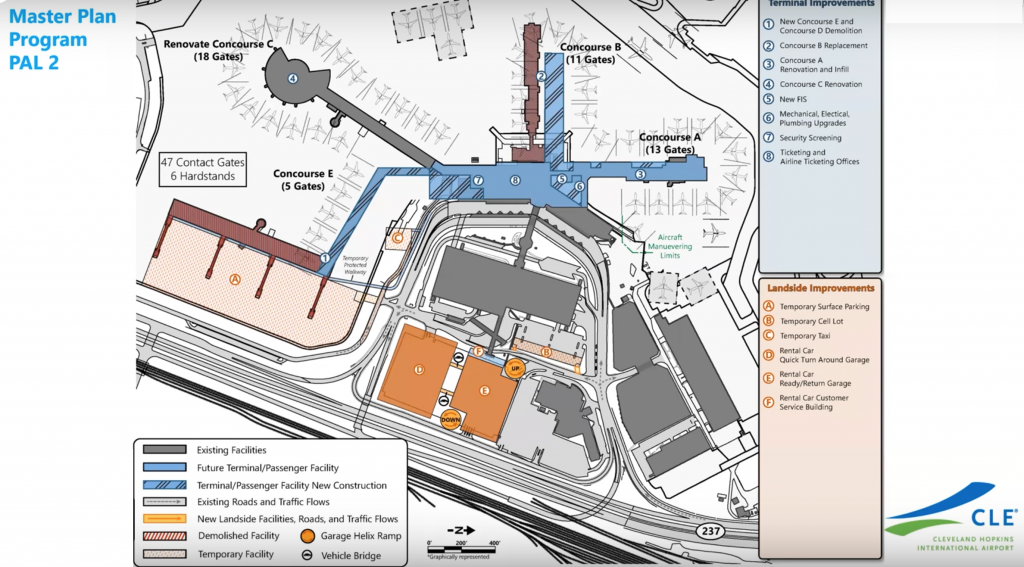
Crain’s Cleveland Business – The proposed $2 billion master plan to overhaul Cleveland International Hopkins Airport would create a larger terminal, four new concourses, more public parking and a direct connection from Interstate 71 into the facility.
The new plans take into account the major changes in air travel over the past few decades, according to Robert Kennedy, director of port control at the Cleveland Airport System.
“The core part of our facilities were designed and built when propeller aircraft was the dominant aircraft in the air, and things have changed significantly since,” he said. “The dominant aircraft size at this airport was a 76-seater. Our average size today is 112 seats, with some carriers running exclusively 220-passenger aircraft.”
Kennedy unveiled the Cleveland Airport Master Plan update to members of Cleveland City Council’s Transportation Committee on Wednesday, May 19. The plan is scheduled to be presented in a virtual public meeting on Wednesday evening.
The master plan, which has been in the works since Mayor Frank Jackson requested the study in October 2019, would be massive, with a renovation of about 30% of the airport and new construction covering the remaining 70%, Kennedy said.
The new plan aims to reduce wait times outside the airport by adjusting curb configuration. It suggests adding 4,000 more walkable public parking spaces; expanding by 600 the number of rental car spaces; and making improvements in public transit accessibility.
It also addresses the need for expanded space for ticketing, baggage inspection, security screening checkpoints, gates and gate waiting areas.
Kennedy said six initial plan options were reduced to two before officials settled on the final proposal. The plan creates more terminal space while allowing the airport to remain open during construction. It also requires lower maintenance and replacement costs over time and provides more “opportunities for non-aeronautical revenue and concession improvements,” he said.
Referring to the existing terminal as a “pre-9/11 design,” Kennedy spoke of the need to reconfigure the land around the terminal, which includes dropoff, parking and car rental areas that were designed and built when the airports saw fewer travelers.
Demand has been exceeding capacity for both the terminal and property around the airport, and the new plan identifies potential options for deferring projects if financially necessary, Kennedy said.
For those driving to and from the airport, the plan would increase the distance between the airport entrance and terminal, eliminate traffic signals coming into the airport, and revise the interchange, creating a direct connection from Interstate 71 while eliminating airport traffic on state Route 237.
“Approximately 95% of the airports in the country, similar in size to ours or larger, have a configuration like this where they have a direct connection to a major interstate,” Kennedy said. “We are in that 5% group that are tied into more of a state or local route.”
The overall cost of the project, including a 20% margin of error, is about $2.06 billion — $780.2 million for the first phase and $853 million and $435.1 million for follow-up phases.
The cost of the master plan would be paid for by airport revenue, bonds and, if available, federal grants, Kennedy said.
“It is not reliant upon tax revenues from the local municipality,” he said.
The plan involves trigger levels based on airport capacity rather than calendar deadlines to guide the multistage redevelopment. The planning activity levels, or PALs, are based on total passenger numbers reaching 13.5 million annually.
In 2019, more than 10 million passengers traveled through Hopkins, but that figure plummeted by 40% by the end of 2020, said Dennis Kramer, chief of planning and engineering. However, he said, Hopkins now is seeing increases in travel at a higher rate than the national average.
“Cleveland is recovering at about 57% and the national average is recovering at about 51%,” Kramer said. “In our last seven days, we have averaged over 20,000 guests through the doors, and we are forecasting over 2 million people will come through this summer.”
The airport master plan next requires approval from the Federal Aviation Administration. It’s a process that can take up to six months, Kennedy said.
Master Plan 3rd Meeting: https://www.youtube.com/watch?v=gfY3M3eeKnM&feature=emb_title&ab_channel=RS%26H






